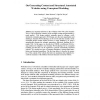Free Online Productivity Tools
i2Speak
i2Symbol
i2OCR
iTex2Img
iWeb2Print
iWeb2Shot
i2Type
iPdf2Split
iPdf2Merge
i2Bopomofo
i2Arabic
i2Style
i2Image
i2PDF
iLatex2Rtf
Sci2ools
ER
2006
Springer
2006
Springer
On Generating Content and Structural Annotated Websites Using Conceptual Modeling
An important milestone in the evolution of the Web is the Semantic Web: a Web in which the semantics of the available content and functionality is made explicit. Web design methods, originally aimed at offering a wellstructured, systematic approach to Web design, now face new opportunities and challenges: Semantic Web technology can be used to make the semantics of the conceptual design models explicit; however a major challenge is to (semi-) automatically generate the semantic annotations, effectively enabling the Semantic Web. In this paper, we describe how WSDM, a well-known Web design method, was adapted to use Semantic Web technology for its conceptual modeling and how this can be exploited to generate semantically annotated websites. We consider two types of semantic annotations: content-related annotations and structural annotations. The first type allows to describe the semantics of the content of the website, the latter are annotations that explicitly describe the semantics of...
| Added | 22 Aug 2010 |
| Updated | 22 Aug 2010 |
| Type | Conference |
| Year | 2006 |
| Where | ER |
| Authors | Sven Casteleyn, Peter Plessers, Olga De Troyer |
Comments (0)

